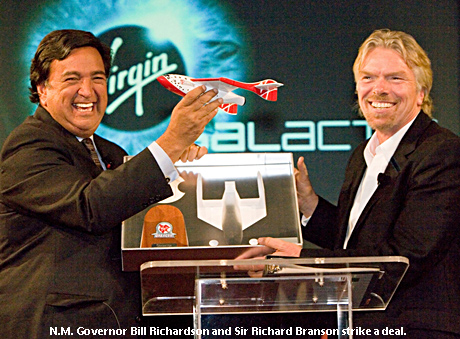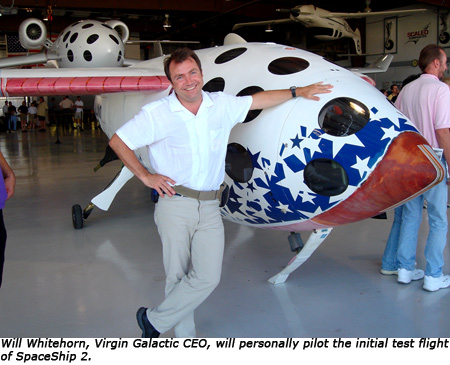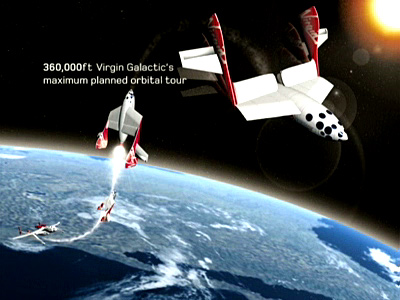Update! The big day has arrived! Congratulations Richard Branson and Virgin Galactic Unity 22 successful flight into space!
I was once a child with a dream looking up to the stars. Now I'm an adult in a spaceship looking down to our beautiful Earth. To the next generation of dreamers: if we can do this, just imagine what you can do https://t.co/Wyzj0nOBgX #Unity22 @virgingalactic pic.twitter.com/03EJmKiH8V
— Richard Branson (@richardbranson) July 11, 2021
I have dreamt about this moment since I was a child, but going to space was more magical than I ever imagined https://t.co/Wyzj0nOBgX #Unity22 @virgingalactic pic.twitter.com/grs7vHAzca
— Richard Branson (@richardbranson) July 11, 2021
NEW TIME: Watch #UNITY22 launch and livestream TODAY at 7:30 am PT | 10:30 am ET | 3:30 pm BST.
Overnight weather delayed the start of flight preparations, but we are on track to fly today with a newly scheduled time.
WATCH: https://t.co/5UalYT7Hjb pic.twitter.com/wkPtjNDM1V
— Virgin Galactic (@virgingalactic) July 11, 2021
Our article, 15 years ago:
It was July 20, 1969, when all the world watched as Neil Armstrong went where no man had gone before. At 10:56 p.m. EDT, Armstrong stepped down onto the moon and made his famous statement, “That’s one small step for man, one giant leap for mankind.” Among those who witnessed history on their black-and-white TV was a little boy named Richard. This made an impression that would remain with him his entire life. And down the line, Richard Branson would create the first company in history to offer commercial tourism to space, Virgin Galactic.
Sir Richard Branson, a.k.a. rebel billionaire, global adventurer, world record-setter, entrepreneur, and founder/chairman of the Virgin Group of companies, is amazing the world again and making available and affordable the adventure of a lifetime for all. Watch the video.
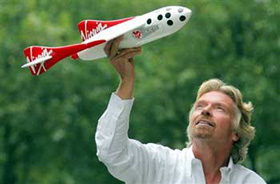
Not one to stop at anything, Branson naturally sought a faster, higher progression. It only made sense that he would spearhead what is being dubbed “The Private Spaceflight Revolution”. If Branson has his way – as he’s been known to in the past – sub-orbital space travel will become a reality for thousands of citizens the world over, and the space timeline will look something like this:
HISTORY
- 1961: Yuri Gagarin becomes the first man in space
- 1969: Neil Armstrong becomes the first man to walk on the moon
- 1996: Original plans for the Ansari X prize announced; $10 million for the first non-government human space flight
- 2001: Paul Allen’s vision leads to the creation of SpaceShipOne by legendary aviation designer, Burt Rutan
- 21 June 2004: The first manned space flight by a private, non-government program, Mike Melvill flying SpaceShipOne
- 27 September 2004: Sir Richard Branson and Burt Rutan announce plans for the world’s first commercial manned space operator, Virgin Galactic
- 29 September 2004: Mike Melvill pilots the first successful X Prize qualifying flight, reaching 330,000 feet
- 4 October 2004: Brian Binnie pilots the final X Prize flight, reaching a record 368,000 feet; the X Prize is won
- 2008: First Virgin Galactic civilian flight launched in Mojave, California
- 2009: First specially built commercial spaceport finishes construction in Upham, New Mexico
Upon its debut, Virgin Galactic will not be for everyone. The initial ticket price stands at $200,000 per passenger (a vast improvement over Dennis Tito’s $20 million bill for his trip aboard the Russian Soyuz), but costs are expected to come down over time. Rather, the other aspect of the revolution will be prying aerospace from exclusive government control. In the 30-plus years since Neil Armstrong first walked on the moon, only 444 people have been allowed to venture out of the atmosphere. Compare that to Virgin Galactic’s plan to inaugurate 3,000 new astronauts in its first five years and up to 10,000 people a year as the industry grows.
Lest you think Virgin Galactic is the trendy ravings of a rich man, you should know that the idea has been percolating within the Virgin Group since the last decade. According to Will Whitehorn, CEO of Virgin Galactic, “The history of Virgin Galactic goes back to the mid-1990s when Sir Richard Branson identified that new technologies in composite materials, rocketry, and computing could easily lead to the development of safe, economical reusable spacecraft in the future. At that time, we registered the Virgin trademark in the area of space travel. In 1999, we registered the Virgin Galactic name.” Whitehorn himself has nearly 30 years of aviation experience, having previously worked for British Airways before joining Virgin in 1987. What made it possible now is the $10 million Ansari X Prize, modeled upon early aviation contests that ultimately lead to the development of the aerospace industry as we know it. In 2004, the X Prize resulted in the first non-government human space flights, and among the 26 teams from seven countries competing, the group financed by Microsoft co-founder Paul Allen and legendary aviation designer Burt Rutan emerged victoriously. SpaceShipOne flew past 100km twice in as many weeks and grabbed headlines along the way.
This historical design will serve as the basis for Virgin Galactic’s spacecraft, dubbed SpaceShipTwo. The maiden ship VSS (Virgin SpaceShip) Enterprise will be joined by the four other vehicles currently on order. For his design, Rutan drew inspiration from the early years of interplanetary transport. Though our astronauts and other space travelers are currently launched outside of earth’s atmosphere on, in essence, huge missiles, the early pioneers had other plans. They envisioned a system in which passengers would travel to a specific point, then be propelled into space proper. But with the advent of the Cold War, space programs had to change direction and follow the lead of the military by building missiles.
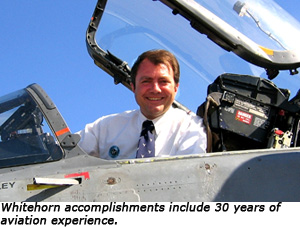
Not content to buck industry expectations simply by existing, Virgin Galactic extends Branson and company’s reputation for anticipating consumer trends and desires, and the iconoclastic touch can be seen in their environmental plan. Rutan has hit upon the use of nitrous oxide (laughing gas) and rubber for lift-off. Though the two are inert on their own, an amazing amount of energy can be created when the nitrous oxide is forced onto the rubber, then ignited. This method is not only safer than liquid propulsion systems or solid fuel rockets, it’s environmentally friendly as well. It’s hard to say which innovation is the greatest, but all three are certainly noteworthy.
But what about the flight itself? The mothership will fly out to 50,000 feet, spaceship in tow. After release, the rocket will fire, and the spaceship will accelerate to three times the speed of sound to reach a maximum altitude of at least 100km. Meanwhile, you, along with six other people and two pilots, will occupy each flight and enjoy the airplane-like environment of the spaceship. The cabin will be fully pressurized through the entire flight, but a tethering mechanism will allow you to leave your seat to experience about five minutes of weightlessness. Meanwhile, you can also drink in the staggering 1,000-mile view out of your picture window. At the end of your two-hour sojourn, you’ll enjoy a gentle reentry and receive your “wings.”
Passengers themselves will fall into three categories. The first 100 travelers to pay the full ticket price up front will be considered Founders. Their seat assignments will be determined in a grand drawing. With an initial deposit of $100,000 on the full ticket price, Pioneers will be among the first 1,000 humans to fly into space without government assistance. Finally, Voyagers can reserve their seat by putting down 10% of the ticket price. More than 60,000 people have registered to fly with Virgin Galactic since 2004, but only about 200 have paid full or partial deposits totaling about $16.4 million, according to the company. That money is refundable if flights, which would have six passengers and two crew, never take off.
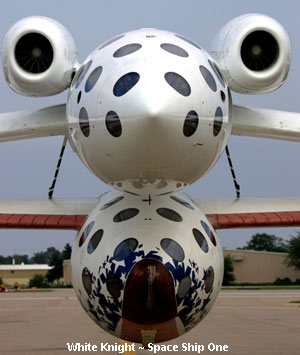
The Virgin way is to redefine and revolutionize, and in that regard, Virgin Galactic is no different from Sir Richard Branson’s other ventures–except, of course, that it is truly like nothing else on earth. By working with a team bearing a proven track record, emphasizing safety, and providing comfort, Branson has made space travel accessible and palatable to the private individual. Along the way, they have also created an eco-conscious fuel alternative and laid the foundation for future growth. But for those who fantasized about becoming an astronaut when they grew up, all that matters is that your dream might just now come true.
www.VirginGalactic.com Click here to see the video


